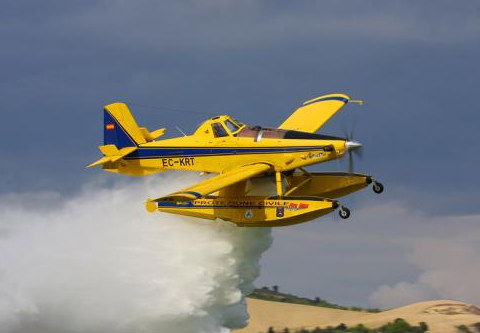On July 14, 2016 the Transportation Safety Board (TSB) of Canada released the Investigation Report about the crash of a Conair Air Tractor AT-802A that occurred August 14, 2014. The crash took place as the air tanker was attempting to lift off after scooping water on Chantslar Lake in British Columbia. The pilot incurred minor injuries and the aircraft sank.

The investigators concluded that a wing stalled either independently or in combination with an encounter with a wing-tip vortex generated by another aircraft.
Below is the TSB’s Summary of the incident:
An Air Tractor AT-802A on amphibious floats (registration C-GXNX, serial number AT- 802A-0530), operating as Tanker 685, was carrying out wildfire management operations during daylight near Chantslar Lake, British Columbia. Three similar aircraft were working as a group with Tanker 685, which was second in line on a touch-and-go to scoop water from Chantslar Lake. Upon liftoff, control was lost and the aircraft’s right wing struck the water. The aircraft water-looped, and the floats and their support structure separated from the fuselage. The aircraft remained upright and slowly sank.
The pilot received minor injuries, egressed from the cockpit, and inflated the personal flotation device being worn. The third aircraft in the formation jettisoned its hopper load as it continued its takeoff and remained in the circuit. The fourth aircraft jettisoned its hopper load, rejected its takeoff, and taxied to pick up the accident pilot. There was sufficient impact force to activate the on-board 406- megahertz emergency locator transmitter, but the search-and-rescue satellite system did not detect a signal from the emergency locator transmitter until the wreckage was being recovered 6 days later.
The TSB’s findings, in part:
1. A wing stalled either independently or in combination with an encounter with a wing-tip vortex generated by the lead aircraft. This caused a loss of control moments after liftoff, and resulted in the right-hand wing tip contacting the water and in a subsequent water-loop.
2. The operator’s standard takeoff procedures did not specify a liftoff speed for scooping operations. Lifting off below the published power-off stall speed contributed to a loss of control at an altitude insufficient to permit a recovery.
3. The takeoff condition, with the aircraft heavy, its speed below the published power-off stall speed, and a high angle-of-attack contributed to the loss of control.
4. An understaffed management structure during organizational changes likely led to excessive workload for existing managers. This contributed to risks, contained within the standard operating procedures, not being addressed through the operator’s safety management system, resulting in continued aircraft operations below published minimum airspeed limitations.
The report states that Conair hired a safety manager and a company check pilot for the Fire Boss fleet before the 2015 spring training season started. And, Conair adopted a risk mitigation plan for 2015–2016, applicable to the company’s AT-802 fleet. The plan addresses issues mentioned in the TSB report, plus an additional issue identified in-house.
The year following the August 14, 2014 crash on Chantslar Lake there were three incidents that we are aware of that involved Conair AT-802’s:
- 2015, April 11: An engine failure on Air Tanker 699, an Air Tractor AT-802A, during training resulted in damage to a float upon landing. The incident occurred April 11, 2015 on Harrison Lake, BC, 33 nm NNE of Abbotsford.
- 2015, May 22: A Conair 802-F Fire Boss crashed in Alberta, killing the pilot, William Hilts.
- 2015, July 10: A Conair Air Tractor 802-F Fire Boss was scooping water from Puntzi Lake in B.C. (map) when the plane had some sort of difficulty and sank.

It would seem to me that the installation of an AOA indicator system on fixed wing air tankers would be very useful. It provides essential stall margin information when your mission requires maneuvering at slow speeds and varying gross weights.